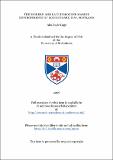Files in this item
The modern and late Holocene marine environments of Loch Sunart, N.W. Scotland
Item metadata
| dc.contributor.advisor | Austin, W. E. N. (William E. N.) | |
| dc.contributor.author | Cage, Alix Gayle | |
| dc.coverage.spatial | xviii, 398, [10] p. | en_US |
| dc.date.accessioned | 2018-08-30T13:59:48Z | |
| dc.date.available | 2018-08-30T13:59:48Z | |
| dc.date.issued | 2006-06-22 | |
| dc.identifier.uri | https://hdl.handle.net/10023/15910 | |
| dc.description.abstract | The first study to exploit the sedimentary archives of Loch Sunart, a relatively well-flushed fjord on the NW coast of Scotland, for palaeoenvironmental reconstruction is presented. In order to understand environmental influences on past environments, the modern physical, chemical and biological conditions of the loch and surrounding catchment were studied. Both observational and computer modelled annual inner basin salinity show a clear response to climatic forcing, modulated by NAO behaviour. Main basin salinity appears to remain very stable and a well-defined salinity: δ¹⁸O relationship suggests excellent potential for palaeotemperature reconstructions based on foraminiferal δ¹⁸O . Multi-variate statistical analyses identified 4 benthic foraminiferal assemblage groups in the surface sediments of the loch: A) restricted basin (E. scaber); B) very high current activity (C. lobatulus-A. mammilla -A. beccarii); C) calm environment undera stratified water column (B. marginata-N. turgida-S. fusiformis) and D) coastal water influence and mild/episodic current activity (A. beccarii-C. lobatulus-S. wrightii-E. excavatum). Using assemblage data, an existing benthic foraminiferal transfer function was modified in order to reconstruct Loch Sunart bottom water temperature (BWS); these reconstructions agree well with Scottish coastal temperature series (Millport). C. lobatulus appears to calcify close to theoretical equilibrium δ¹⁸O calcite (Δδ¹⁸O = -0.11 ± 0.17 %), probably during the warm bottom water temperatures (BWT) of late autumn, and predominantly reflects changes in BWT rather than BWS in the main basin of Loch Sunart. The first late Holocene high resolution palaeoenvironmental reconstruction from the deep (121 m) main basin of Loch Sunart is presented; gravity core (GC023) is 3 m long and spans the last 2,000 years. Despite difficulties with geochronology, palaeoenvironmental reconstructions from Loch Sunart suggest that these high resolution sedimentary archives have the potential to resolve inter-annual marine climate variability of the order of 1-2°C and capture an integrated record of changes in the catchment and marine environment. | en_US |
| dc.language.iso | en | en_US |
| dc.publisher | University of St Andrews | |
| dc.title | The modern and late Holocene marine environments of Loch Sunart, N.W. Scotland | en_US |
| dc.type | Thesis | en_US |
| dc.contributor.sponsor | University of St Andrews | en_US |
| dc.contributor.sponsor | Scottish International Education Trust | en_US |
| dc.contributor.sponsor | Russell Trust | en_US |
| dc.type.qualificationlevel | Doctoral | en_US |
| dc.type.qualificationname | PhD Doctor of Philosophy | en_US |
| dc.publisher.institution | The University of St Andrews | en_US |
This item appears in the following Collection(s)
Items in the St Andrews Research Repository are protected by copyright, with all rights reserved, unless otherwise indicated.

